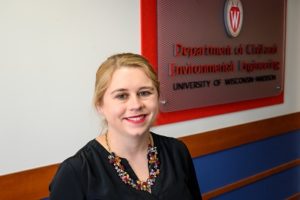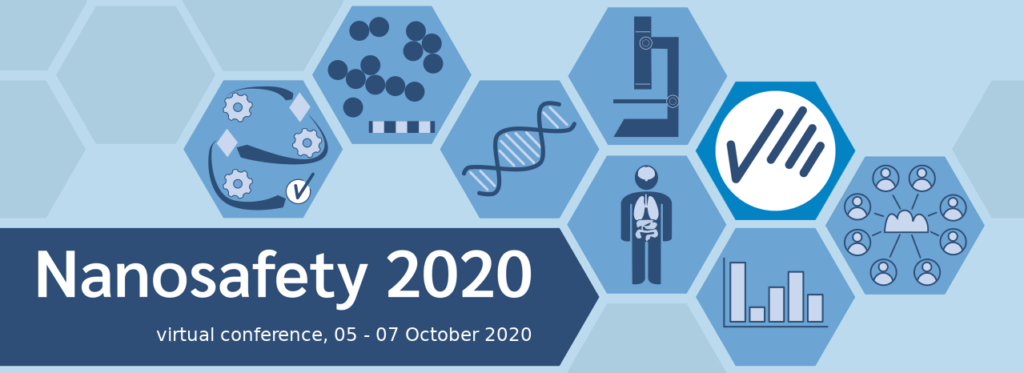 Andrea Hicks is an assistant professor at the University of Wisconsin – Madison in the Civil and Environmental Engineering Department. Her work broadly focuses on the environmental impacts of emerging technologies. She completed her undergraduate studies at Michigan Technological University in Environmental Engineering, and her M.S. in Environmental Engineering at Clemson University. Dr. Hicks completed her doctoral and post-doctoral work at the University of Illinois at Chicago in Civil Engineering and at the Institute for Environmental Science and Policy. She is a recipient of a National Science Foundation CAREER award, UW-Madison Community Based Learning Teaching Award, and the Sustainable Nanotechnology Organization’s Emerging Investigator Award.
Andrea Hicks is an assistant professor at the University of Wisconsin – Madison in the Civil and Environmental Engineering Department. Her work broadly focuses on the environmental impacts of emerging technologies. She completed her undergraduate studies at Michigan Technological University in Environmental Engineering, and her M.S. in Environmental Engineering at Clemson University. Dr. Hicks completed her doctoral and post-doctoral work at the University of Illinois at Chicago in Civil Engineering and at the Institute for Environmental Science and Policy. She is a recipient of a National Science Foundation CAREER award, UW-Madison Community Based Learning Teaching Award, and the Sustainable Nanotechnology Organization’s Emerging Investigator Award.
Read Andrea Hick’s Emerging Investigator Series article “Emerging investigator series: calculating size- and coating-dependent effect factors for silver nanoparticles to inform characterization factor development for usage in life cycle assessment” and read more about her in the interview below:
Your recent Emerging Investigator Series paper focuses on ‘Calculating size- and coating- dependent effect factors for silver nanoparticles to inform characterization factor development for usage in life cycle assessment’. How has your research evolved from your first article to this most recent article?
My role in the article preparation has changed. I was a PhD student when I wrote my first article, working with my advisor Dr. Tom Theis. Whereas now I am the PhD advisor, writing this work with my student Sila Temizel-Sekeryan. Which is a different experience. In general, I have always been interested in emerging technologies, such as engineered nanomaterials. In my first article, as part of my PhD work, I was studying light emitting diodes, and their potential for energy efficiency rebound. And while the rebound effect, or Jevons’s paradox is still part of some of my work, engineered nanomaterials are another interesting emerging technology which like light emitting diodes, have the potential to influence environmental impact due to their ubiquity.
What aspect of your work are you most excited about at the moment?
This work is particular is really exciting. I have studied the environmental impacts of nano-scale silver in consumer products before, such as textiles, and a question that was always part of that work was how to model the environmental impacts of the nano-scale silver itself as a part of the life cycle assessment. In this work, we took some of the first steps to better understand how to incorporate the impact of the nano-silver itself into the assessment. This work would not have been possible without a great deal of work having already been done by experimentalists in order to understand the toxicity of nano-silver.
In your opinion, what are the most important questions to be asked/answered in this field of research?
Speaking broadly about emerging technologies, which include engineered nanomaterials, what I think is the most important question is whether or not an advance is societally beneficial. Advances in technology have had a great benefit to society in general, but at the same time there is also an environmental cost. I think that it is critical to evaluate the environmental impacts of new technologies and potential unintended consequences before they are broadly adopted.
What do you find most challenging about your research?
Emerging technologies are often challenging to study, because they are just that, emerging. It is often difficult to obtain enough information to model these products, either using life cycle assessment or other tools. One way to counter this is to work with other researchers who are actually developing these new technologies and products, to secure the necessary information. What is really exciting about working with people who are researching the technologies themselves allows us to use the life cycle assessment data that we generate, to refine the new technology to make it less environmentally costly.
In which upcoming conferences or events may our readers meet you?
2020 is turning out to be an interesting year for conferences and events, with many being cancelled or moved to fully digital formats, particularly in the United States where I live. In general, I like to attend the North American Society of Environmental Toxicology and Chemistry annual meeting, Sustainable Nanotechnology Organization annual meeting, and the International Society for Industrial Ecology meetings. I was fortunate to be able to attend the second Pan-American Nanotechnology Conference in Brazil early this past spring, before everything shutdown. I’m also a faculty member at the University of Wisconsin-Madison in our Department of Civil and Environmental Engineering, and in normal times am on campus.
How do you spend your spare time?
That is a particularly interesting question in 2020. Aside from doing work which I love, I am also a mother to two energetic grade school children and have wonderful husband. I like to spend my spare time with them. In spring 2020 when our school district and daycare shutdown, spare time did not really exist anymore, because I was working and teaching remotely, while supervising my children’s online learning.
Which profession would you choose if you were not a scientist?
When I was younger, I thought about a lot of different careers, and my main goal was to do something where I felt I could make a difference in the world. Which I know sounds terribly idealistic. I thought for quite a while about being a journalist and writer, documenting people’s stories and bringing them to a wider audience. Or a photographer, like Dorothea Lange, who used her photos to document the human consequences of the Great Depression. Or maybe a medical doctor, making a difference in the lives of my patients. Or a sculptor, bringing art and beauty to the world. It’s actually a really hard question.. I’m lucky that I have a job I really enjoy, where I get to work on cutting edge science, teach and mentor students, and do service in the community.
Can you share one piece of career-related advice or wisdom with other early career scientists?
When you see the career trajectory of someone you admire, and wonder how you could ever be that good, you need to remember that they got there one step at a time. It all starts with a single step, applying for an opportunity, or writing a manuscript or defending a dissertation. They didn’t become who they are overnight, it took time. You just need to keep putting one foot in front of the other, and if you do that diligently you be amazed at the heights you can reach.












 We are delighted to share with you a hand-picked selection of papers recently published in
We are delighted to share with you a hand-picked selection of papers recently published in 









